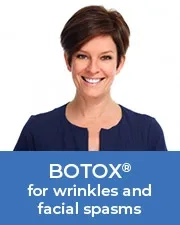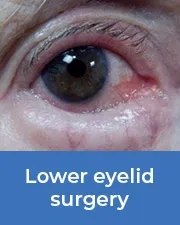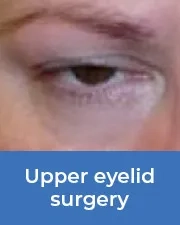Eyecare for adults
For information on the conditions and what treatment options are available, click through the menu below.
Strabismus
Strabismus is a condition in which each eye appears to look in a different direction. It is commonly termed, 'lazy eyes', ‘misaligned eyes’, ‘wandering eyes’, or ‘crossed eyes’ and can affect children and adults. One eye typically points straight ahead, while the other turns inward, outward, upward, or downward.
Myths about strabismus
Myth 1: Strabismus cannot be treated as an adult
This is false. Strabismus can be effectively treated in both children and adults.
Myth 2: Misalignment of the eyes is only cosmetic, and therefore will not be paid for by insurance carriers.
This is also false. Eye muscle surgery is almost always covered by medical insurance and has nothing to do with a "vision plan".
Myth 3: Eye muscle surgery is painful.
Most patients report minimal discomfort. Plus, the recovery period is quick, meaning you can get back to work in a couple of days.
Strabismus treatment for adults
Many adults with strabismus simply never had the condition treated as a child. For others, the condition may have actually worsened during their progression from childhood to adulthood. Alternatively, some adults who had strabismus surgery as a child, feel the eyes begin to drift again years later.
Treatment is the same as it is for children: surgery to reposition and rebalance the muscles causing the misaligned eye. During adult strabismus surgery, Dr. Wasserman straightens the eyes to make them work together binocularly. Patients sleep through the surgery, and will go home the same day.
Strabismus surgery does not involve any cutting of the skin, and will leave no scars on the skin afterward. During surgery, Dr. Wasserman will reposition the eye muscles on the sides of the eye, depending on which direction the eye is misaligned. Generally, dissolvable sutures will be used, and patients will not require eye patches, allowing them to return home with their eyes open and functional.
Recovery from surgery is typically very quick, with most patients resuming their normal activities in just a few days.












BOTOX® for wrinkles and facial spasms
BOTOX® has been used by eye surgeons for over 20 years. Dr. Wasserman has safely and successfully treated many patients with BOTOX® for both medical (Blepharospasm and Hemifacial spasm) and cosmetic reasons. If you are approaching your thirties, or forties, or are older, you may have already noticed the beginnings of "expression lines" like "crow's feet". BOTOX® is a natural, safe, and temporary method of dramatically improving or eliminating the appearance of these fine lines and wrinkles.
BOTOX® is injected in minute quantities into the muscles that cause the wrinkles, within days, the lines and wrinkles are reduced. Months later, as the effects wear off, a simple re-treatment is all that's needed to maintain a youthful appearance. This simple, quick procedure is performed in the office. BOTOX® is the procedure of choice for many people, and at times, no other procedure can come close to its results. BOTOX® is an effective, affordable, non-surgical procedure that will take years off your appearance. Call today for a complimentary, personalized consultation with Dr. Wasserman and see why some people are calling BOTOX® "The Mini Face Lift".
Did you know? Botox was actually developed by a pediatric ophthalmologist for kids with crossed eyes. Later it was used for eyelid spasms and then found that those patients had less 'crows feet' lines.
Lower eyelid surgery
Ectropion is the outward turning of the lower eyelid. The natural aging process stretches the skin of the lower eyelid, causing it to droop down and turn outward. This condition is called ectropion and can be corrected with surgery. Without treatment, patients may experience dry eyes, excessive tearing, redness and sensitivity to light and wind.
Entropion is the inward turning of the lower eyelid. Also caused by aging, as well as eye infections and scarring, people with entropion have eyelashes and skin that rub against the eye making it red, irritated and sensitive to light and wind. If not treated, these symptoms will persist, and there is an increased risk of infection.
Dr. Wasserman will do a thorough examination, take photos and visual field tests. These will be submitted to your insurance carrier prior to lower eyelid surgery. All adult eyelid plastic surgeries are done on an outpatient basis and under local anesthesia. Congenital cases of children are also outpatient but performed under general anesthesia.


Blepharoplasty: Upper eyelid surgery
Blepharoplasty, or upper eyelid surgery, is a procedure that restores a more youthful, healthy appearance to drooping eyelids. As we age, the skin of our eyelids lose elasticity and can begin to sag, causing the droopy appearance. While it can make us look older, it can also interfere with our field of vision.
The problem
Eyes are a major component in your overall appearance, largely due to the fact that your eyes are often the first thing that people notice about you. Unfortunately, even with a good night's sleep, loose skin over your eyes can make you look tired, and appear older than you really are.
The procedure
The procedure is performed in a office based surgical suite or ASC. You can plan on being there for one to two hours and have a driver take you home. Excess skin (that causes wrinkles) and unwanted fatty tissue (that creates heaviness of the lid) are removed, and the muscle around the eye is tightened, if necessary. The incisions will be closed with very fine sutures that will be removed in seven days.
Eyelid surgery (Blepharoplasty) is usually considered cosmetic or elective surgery and is not covered by insurance. However, if your vision is affected by droopy lids, your insurance may cover the procedure as “medically necessary”.





Contact us
If you're in need of any of these treatments, and want to learn more about how Dr. Barry Wasserman can help, please contact us at 609‑243‑8711.
We'd be happy so set up and initial appointment, or simply answer your questions over the phone. We look forward to hearing from you.





